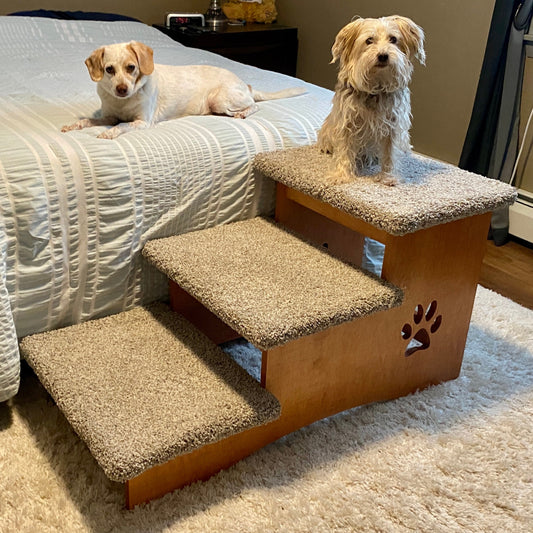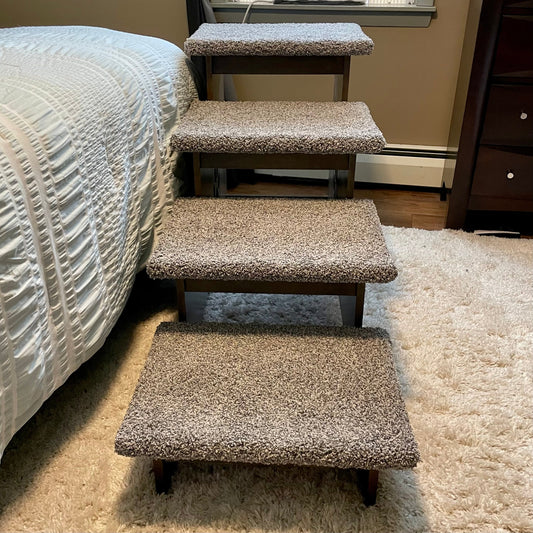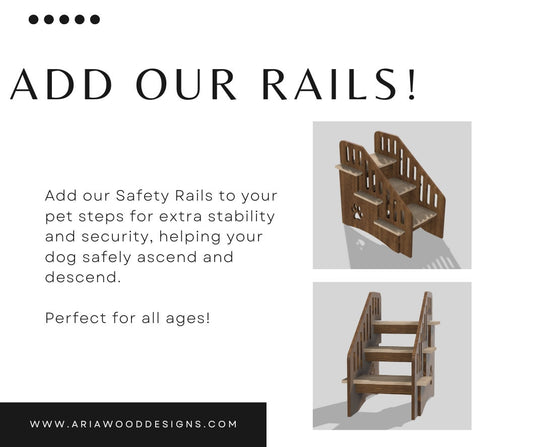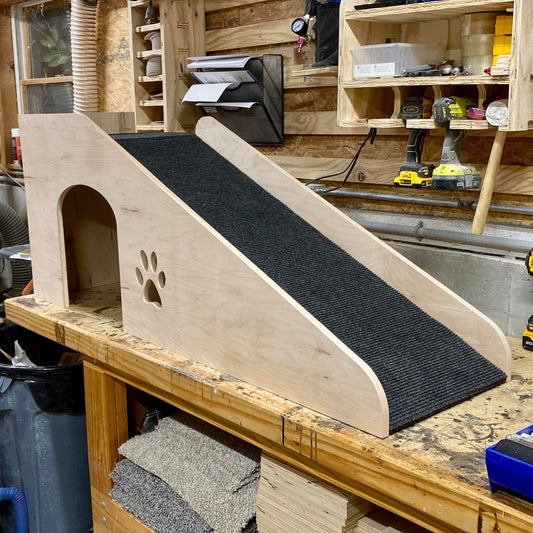When your furry friend struggles to reach their favorite sleeping spot or climb into the car, dog steps can be a game-changer. These simple yet essential tools help pets maintain their independence while protecting their joints from unnecessary strain. Whether you have a small pup who can't quite make it onto the couch or a senior dog dealing with mobility issues, the right pet steps can significantly improve their quality of life.
Dog steps serve as more than just convenience accessories—they're vital health tools that can prevent injuries and reduce stress on your pet's body. From puppies learning to navigate your home to aging dogs with hip dysplasia, these mobility aids offer safe passage to elevated surfaces throughout your house.
This comprehensive guide will walk you through everything you need to know about selecting, using, and benefiting from dog steps. You'll discover the key differences between steps and ramps, learn what features matter most for your specific situation, and understand how to introduce these tools to your pet successfully.

Understanding Different Types of Pet Mobility Solutions
Dog Steps vs. Dog Stairs vs. Dog Ramps
The terminology around pet mobility aids can be confusing, but understanding the differences helps you make the best choice. Dog steps and dog stairs are essentially the same thing—they feature distinct, separate platforms that pets step on one at a time. These work well for most dogs who are comfortable with the stepping motion.
Pet ramps, on the other hand, provide a continuous sloped surface. While they require more floor space, ramps can be easier for some pets to use, especially those with severe joint pain or mobility limitations. Some older dogs who refuse to use steps will readily walk up a gentle ramp.
The choice between steps and ramps often comes down to your pet's comfort level, available space, and specific mobility needs. Many pet parents find that their dogs adapt more quickly to steps because the motion feels more natural.
Standard Steps vs. Extra Deep Pet Steps
Regular pet steps typically feature standard-depth treads, while extra-deep steps provide wider platforms for each step. The additional depth offers several advantages, particularly for larger dogs or pets who need extra confidence when climbing.
Extra-deep steps allow dogs to place all four paws comfortably on a single step, which can be crucial for anxious pets or those recovering from injuries. This design also accommodates dogs with longer bodies who might struggle with standard step depths.
Steps with Storage Features
Some dog steps include hidden storage compartments, making them dual-purpose furniture pieces. These designs help maximize space in smaller homes while keeping pet supplies, toys, or treats conveniently stored.
Storage steps often feature removable tops or hinged sections that reveal compartments beneath. This functionality makes them particularly appealing for apartment dwellers or anyone looking to reduce clutter while providing pet accessibility.

Key Features to Consider as Pet Parents When Buying Dog Steps
Height Requirements
Measuring the height you need is crucial for successful pet step selection. Common heights include 14-inch, 20-inch, 23-inch, and 30-inch options, each designed for specific furniture or vehicle heights.
For standard beds and sofas, 14 to 20-inch steps typically work well. Higher beds or SUVs might require 23-inch or taller options. Always measure from the floor to the surface your dog needs to reach, then select steps that bring them close to that level.
Weight Capacity and Stability
Quality pet steps should easily support your dog's full body weight plus some additional capacity for dynamic loading when they jump or run up the steps. Most well-constructed steps can handle dogs up to 150 pounds or more.
Stability features include wide bases, anti-slip feet, and solid construction materials. Look for steps that won't wobble or shift when your dog uses them, as instability can create fear and reluctance to use the steps.
Step Depth and Width
Adequate step depth allows your dog to place their paws comfortably without feeling cramped or unstable. Small dogs might do fine with standard depths, but larger breeds benefit from extra-deep platforms.
Width is equally important—steps should be wide enough that your dog doesn't feel like they might fall off the sides. This is particularly crucial for breeds with longer bodies or those who lack confidence on elevated surfaces.
Surface Materials and Traction
The step surface material significantly impacts your dog's comfort and safety. Carpeted steps provide excellent traction and comfort for paws, while also reducing noise when pets use them at night.
Some steps feature removable carpet for easy cleaning, while others use textured surfaces or grip strips. Avoid completely smooth surfaces, as these can be slippery and dangerous for pets, especially when they're moving quickly.

Health Benefits of Dog Steps
Joint Protection and Pain Relief
Dog steps reduce the impact on joints that comes from jumping up and down from furniture or vehicles. This is particularly important for breeds prone to hip dysplasia, arthritis, or other joint conditions, while still being comfortable while taking trips around the town with you.
Senior dogs especially benefit from steps, as they may experience pain or stiffness that makes jumping difficult. By providing an alternative path, steps allow aging pets to maintain access to their favorite spots without discomfort.
Injury Prevention
Repeated jumping from heights can lead to both acute injuries and long-term joint damage. Steps eliminate the need for these potentially harmful impacts, protecting your dog's body over their lifetime.
Small dogs are particularly vulnerable to injuries from jumping, as their bones are more delicate relative to their body size. Even young, healthy dogs can benefit from using steps to prevent future problems.
Maintaining Independence
Steps allow dogs to access their preferred resting spots without human assistance. This independence is valuable for both pets and owners, reducing the need for constant lifting while preserving the dog's autonomy.
For dogs recovering from surgery or dealing with temporary mobility issues, steps can be essential for maintaining normal routines and reducing stress during the healing process.

Choosing the Right Size and Style
Measuring Your Space
Before purchasing dog steps, carefully measure both the available floor space and the height you need to bridge. Steps require floor space out extending outward from the furniture, so ensure you have adequate room.
Consider traffic patterns in your home as well. Steps positioned in high-traffic areas might get in the way, while those tucked beside beds or couches integrate more seamlessly into your living space.
Matching Your Home's Aesthetic
Modern pet steps come in various wood finishes, carpet colors, and styles to complement your existing furniture. Many manufacturers offer customization options, allowing you to match your décor perfectly.
Well-designed pet steps can actually enhance your room's appearance rather than detracting from it. Look for pieces that could double as functional furniture, even fold up when your dog isn't using them.
Considering Multiple Pets
If you have multiple dogs of different sizes, you might need to consider their various needs. Some families find success with one larger set of steps that accommodates all their pets, while others prefer multiple smaller sets positioned strategically throughout the home.
Factor in the personalities of your pets as well—some dogs are territorial about their access routes, while others happily share resources.

Training Your Dog to Use Steps
Introduction Techniques
Most dogs need some encouragement to start using steps confidently. Begin by placing the steps in position and allowing your dog to investigate them naturally. Avoid forcing or rushing the process.
Use high-value treats to create positive associations with the steps. Place treats on each step and encourage your dog to retrieve them, gradually building their confidence with the new equipment.
Building Confidence
Start with your dog on the floor and encourage them to step up just one level. Once they're comfortable with single steps, gradually work up to using the full height of the steps.
Some dogs feel more confident going up than coming down initially. Practice both directions, but don't be surprised if one feels more natural to your pet at first.
Troubleshooting Common Issues
If your dog seems afraid of the steps, check for stability issues or noise that might be startling them. Some pets are sensitive to the sound their nails make on certain surfaces.
For dogs who simply refuse to use steps, try different placement positions or consider whether a ramp might be a better option for your particular pet.
Maintenance and Safety Tips
Regular Inspection
Check your pet steps regularly for signs of wear, loose screws, or damage that could compromise safety. Pay particular attention to high-stress areas like step edges and
Carpet surfaces may show wear patterns over time, especially in high-use areas. Replace or refresh carpeting when it becomes too worn to provide adequate traction.
Cleaning and Care
Most carpeted steps can be vacuumed regularly and spot-cleaned as needed. Some manufacturers offer removable carpet sections that can be washed or replaced entirely.
For steps with storage compartments, periodic cleaning of the interior space prevents odor buildup and keeps stored items fresh and accessible.
Proper Placement
Position steps on level, stable flooring away from areas where they might be knocked over. Avoid placing them on rugs that might slip or shift when your dog uses the steps.
Ensure adequate lighting around the steps, especially if your dog might use them at night. Poor visibility can lead to missteps or falls.
When to Consider Professional Help
Mobility Assessment
If your dog suddenly starts having difficulty with steps they previously used easily, consult your veterinarian. Changes in mobility can indicate developing health issues that need attention.
Professional pet behaviorists can help with dogs who have developed fears or anxieties around using steps, especially after negative experiences.
Custom Solutions
Some pets have unique needs that require custom-built solutions. Professional woodworkers or pet furniture specialists can create steps tailored to specific height requirements or space constraints.
Consider professional installation for permanent or built-in step solutions, especially those that need to be securely anchored for safety.
Why Choose Aria Wood Designs?
At Aria Wood Designs, we prioritize your pet's comfort, safety, and well-being. We understand that choosing the perfect pet steps involves more than just functionality—it's about enhancing your furry friend's quality of life.
Our steps are thoughtfully crafted with all the factors mentioned above in mind, from precise sizing that ensures a seamless fit to durable materials designed for long-term use. Whether your pet is small, aging, or recovering from an injury, our products are tailored to meet their specific needs.
What sets Aria Wood Designs apart is our commitment to quality and style. Our pet steps are not only practical but also add a touch of elegance to your home. With meticulous construction and attention to detail, we guarantee that our steps will serve both you and your pet perfectly for years to come.
Visit our website today to explore our collection and find the ideal solution for your beloved companion!

Making the Investment Work for You
Dog steps represent a long-term investment in your pet's health and comfort. Quality steps should last for many years with proper care, making them cost-effective compared to potential veterinary bills from jumping-related injuries.
When shopping for pet steps, prioritize quality construction and appropriate sizing over the lowest price. Well-made steps provide better safety, last longer, and offer superior value over time.
Consider your dog's likely needs as they age, even if they're currently young and healthy. Steps that might seem unnecessary now could become essential as your pet enters their senior years.
The right dog steps can transform your pet's daily experience, providing safe, comfortable access to their favorite spots while protecting their long-term joint health. Take time to assess your specific needs, measure carefully, and choose steps that will serve both you and your furry friend well for years to come.









